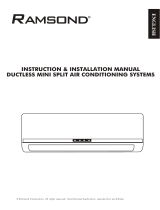
Thank you for choosing White Westinghouse. This manual contains all of the
information required to guarantee your safety and the appropriate use of
your air conditioner.
Please read all of the instructions before using the air conditioner and keep
this manual for future reference.
We know you will enjoy your new air conditioner and thank you for choosing
our product. We hope you will consider us for future purchase.
The air conditioner that you have bought may be slightly different from the
one illustrated in this manual. Please refer to the information related to the
model you have.
This air conditioner is for domestic use only. It is not reccomended for
commercial or industrial use.
The air conditioner you have may carry a different plug than the one
illustrated in this manual. The plug that comes with the product follows the
electrical specification of the country where it is sold.
The packaging material used is recyclable; we
recommend that you separate plastic, paper and
cardboard and give them to recycling companies.
According to WEEE (Waste of Electrical and Electronic
Equipment) guidelines, waste from electrical and
electronic devices should be collected separately. If
you need to dispose of this appliance in the future,
do NOT throw it away with the rest of your domestic
garbage. Instead, please take the appliance to the
nearest WEEE collection point, where available.
The air conditioner you purchased has R410a gas
refrigerant a environmental friendly gas which does
not damage the ozone layer.
Environmental Advices
Welcome to the world of
simple handling and no worries.
Contents
01. Welcome..................................................................................................01
02. Environmental advices...............................................................................01
03. Contents...................................................................................................02
04. Safety precautions......................................................................................04
05. Prohibitions...............................................................................................09
06. Parts list.....................................................................................................11
6.1 Indoor unit.....................................................................................11
6.2 Outdoor unit...................................................................................12
07. Indoor unit instalation................................................................................13
7.1 Instalation of the mouting plate......................................................14
7.2 Drilling a hole in the wall for piping..................................................14
7.3 Electrical connections.....................................................................15
7.4 Refrigerant piping conection............................................................16
7.5 Conecting the pipes.........................................................................16
6.6 Indoor unit condensed water drainage..............................................17
08. Outdoor unit instalation.............................................................................19
8.1 Outdoor unit condensed water drainage...........................................13
8.2 Electrical conections........................................................................20
8.3 Bleeding.........................................................................................21
09. Operation test ...........................................................................................22
9.1 Installation diagram........................................................................22
9.2 Final tests........................................................................................22
9.3 Indoor unit test ................................................................................23
9.4 Outdoor unit test.............................................................................23
10. Informations.............................................................................................24
10.1 Cable wires specification................................................................25
11. Indoor unit display......................................................................................26
12. Display functions.......................................................................................27
12.1 Auto-restart function......................................................................27
12.2 Emergency function.......................................................................28
13. Remote control..........................................................................................29
13.1 How to insert the batteries..............................................................29
13.2 Recomendations for locating and using remote control................31
14. Remote control description.........................................................................32
15. Remote control display................................................................................34
16. Modes of operation....................................................................................36
16.1 ‘Swing’ control of the airflow...........................................................36
16.2 Cooling mode...............................................................................37
16.3 Heating mode..............................................................................;38
16.4 Timer mode - turn on.....................................................................39
Attention
ContentsWelcome
01 02





















